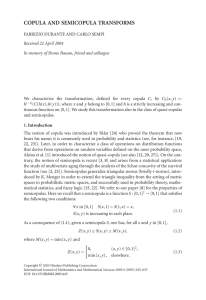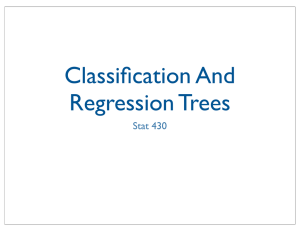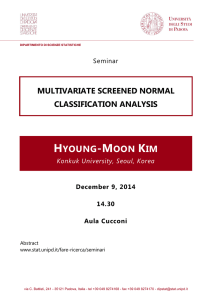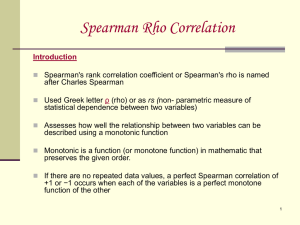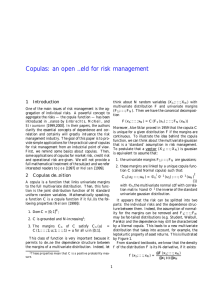Bootstrapping Spearman’s multivariate rho
advertisement
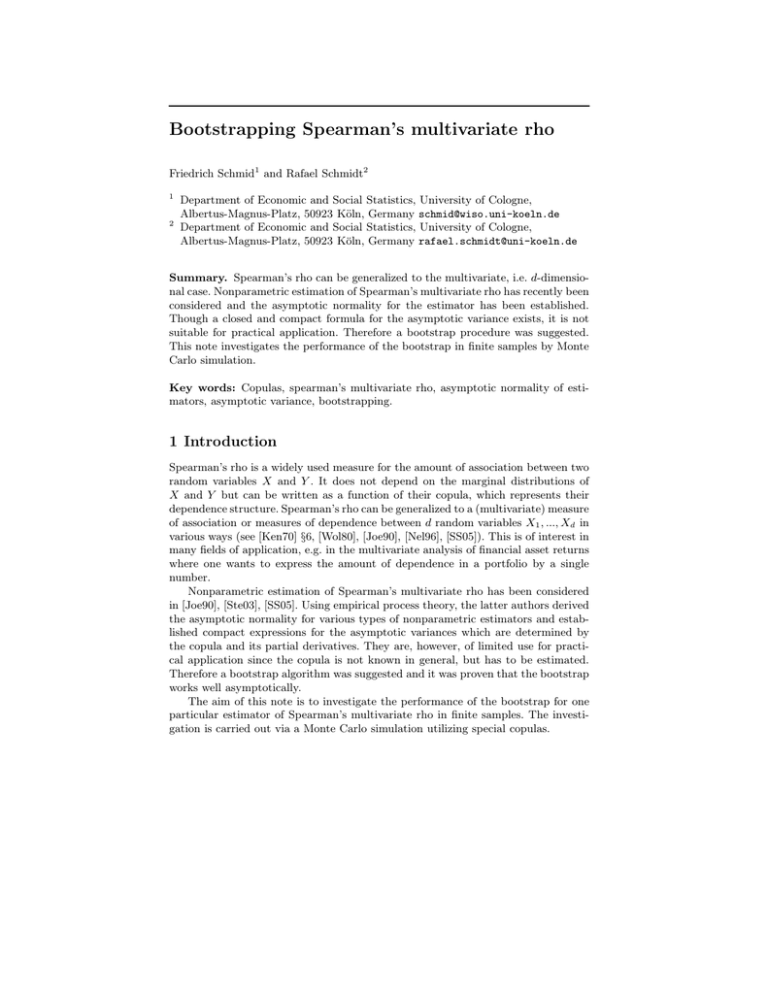
Bootstrapping Spearman’s multivariate rho
Friedrich Schmid1 and Rafael Schmidt2
1
2
Department of Economic and Social Statistics, University of Cologne,
Albertus-Magnus-Platz, 50923 Köln, Germany schmid@wiso.uni-koeln.de
Department of Economic and Social Statistics, University of Cologne,
Albertus-Magnus-Platz, 50923 Köln, Germany rafael.schmidt@uni-koeln.de
Summary. Spearman’s rho can be generalized to the multivariate, i.e. d-dimensional case. Nonparametric estimation of Spearman’s multivariate rho has recently been
considered and the asymptotic normality for the estimator has been established.
Though a closed and compact formula for the asymptotic variance exists, it is not
suitable for practical application. Therefore a bootstrap procedure was suggested.
This note investigates the performance of the bootstrap in finite samples by Monte
Carlo simulation.
Key words: Copulas, spearman’s multivariate rho, asymptotic normality of estimators, asymptotic variance, bootstrapping.
1 Introduction
Spearman’s rho is a widely used measure for the amount of association between two
random variables X and Y . It does not depend on the marginal distributions of
X and Y but can be written as a function of their copula, which represents their
dependence structure. Spearman’s rho can be generalized to a (multivariate) measure
of association or measures of dependence between d random variables X1 , ..., Xd in
various ways (see [Ken70] §6, [Wol80], [Joe90], [Nel96], [SS05]). This is of interest in
many fields of application, e.g. in the multivariate analysis of financial asset returns
where one wants to express the amount of dependence in a portfolio by a single
number.
Nonparametric estimation of Spearman’s multivariate rho has been considered
in [Joe90], [Ste03], [SS05]. Using empirical process theory, the latter authors derived
the asymptotic normality for various types of nonparametric estimators and established compact expressions for the asymptotic variances which are determined by
the copula and its partial derivatives. They are, however, of limited use for practical application since the copula is not known in general, but has to be estimated.
Therefore a bootstrap algorithm was suggested and it was proven that the bootstrap
works well asymptotically.
The aim of this note is to investigate the performance of the bootstrap for one
particular estimator of Spearman’s multivariate rho in finite samples. The investigation is carried out via a Monte Carlo simulation utilizing special copulas.
760
Friedrich Schmid and Rafael Schmidt
The structure of the paper is as follows. Section 2 introduces some notation.
Section 3 defines Spearman’s multivariate rho and presents some asymptotic theory
regarding its nonparametric estimation. Section 4 investigates the performance of
the corresponding bootstrap for special copulas.
2 Preliminary
Throughout the paper we write bold letters for vectors, e.g., x := (x1 , ..., xd ) ∈ Rd
. Inequalities x ≤ y are understood componentwise, i.e, xi ≤ yi for all i = 1, ..., d.
The indicator function on a set A is denoted by 1A . Let X1 , X2 , ..., Xd be d ≥ 2
random variables with joint distribution function
F (x) = P (X1 ≤ x1 , ..., Xd ≤ xd ),
x = (x1 , ..., xd ) ∈ Rd ,
and marginal distribution functions Fi (x) = P (Xi ≤ x) for x ∈ R and i = 1, ..., d
. We will always assume that the Fi are continuous functions. Thus, according to
Sklar’s theorem [Skl59], there exists a unique copula C: [0, 1]d −→ [0, 1] such that
F (x) = C(F1 (x1 ), ..., Fd (xd )) for all x ∈ Rd .
The copula C is the joint distribution function of the random variables
Ui = Fi (Xi ), i = 1, ..., d. Moreover, C(u) = F (F1−1 (u1 ), ..., Fd−1 (ud )) for all
u ∈ [0, 1]d where the generalized inverse function F −1 is defined via F −1 (u) :=
inf {x ∈ R∪ {∞} |F (x) ≥ u } for all u ∈ [0, 1]. A detailed treatment of copulas is
given in [Nel99] and [Joe97].
It is well known that every copula C is bounded in the following sense:
W (u) := max {u1 + ... + ud − (d − 1), 0}
≤ C(u) ≤ min {u1 , ..., ud } =: M (u) for all u ∈ [0, 1]d ,
(1)
where M and W are called the upper and lower Fréchet-Hoeffding bounds, respectively. The upper bound M is a copula itself and is also known as the comonotonic
copula. It represents the copula of X1 , ..., Xd if F1 (X1 ) = ... = Fd (Xd ) with probability one, i.e., where there is (with probability one) a strictly increasing functional
relationship between Xi and Xj (i 6= j) . Another important copula is the independence copula
Π(u) :=
d
Y
i=1
ui ,
u ∈ [0, 1]d ,
describing the dependence structure of stochastically independent random variables
X1 , ..., Xd .
Bootstrapping Spearman’s multivariate rho
761
3 Spearman’s Multivariate Rho and its Estimation
Spearman’s rho for a two dimensional random vector X = (X1 , X2 ) with copula C
can be written as
R1 R1
cov(U1 , U2 )
p
=
ρ= p
var(U1 ) var(U2 )
R1 R1
0 0
=
0 0
uv dC(u, v) − ( 21 )2
1/12
C(u, v) dudv − 1/4
1/3 − 1/4
R1 R1
=
0 0
R1 R1
0 0
because of
R1 R1
M (u, v) dudv = 1/3 and
0 0
C(u, v) dudv −
M (u, v) dudv −
R1 R1
R1 R1
Π(u, v) dudv
0 0
R1 R1
,
(2)
Π(u, v) dudv
0 0
Π(u, v) dudv = 1/4. Thus, ρ can be
0 0
interpreted as the normalized average distance between the copula C and the independence copula Π(u, v) = uv . The following d-dimensional extension of ρ is now
straightforward
R
ρ=
[0,1]d
R
C(u) du −
M (u) du−
[0,1]d
R
R
8
>
<
Π(u) du
[0,1]d
=
Π(u) du
[0,1]d
d+1
2d
>
2d − (d + 1) :
9
>
=
Z
C(u) du − 1
>
;
[0,1]d
.
Consider a random sample (Xj )j=1,...,n from a d -dimensional random vector X
with joint distribution function F and copula C which are completely unknown. It
is further assumed, that the marginal distribution functions Fi are unknown. They
are estimated by their empirical counterparts
F̂i,n (x) =
n
1X
,
1
n j=1 {Xij ≤x}
for i = 1, ..., d and x ∈ R.
Further, set Ûij,n := F̂i,n (Xij ) for i = 1, ..., d, j = 1, ..., n, and Ûj,n =
(Û1j,n , ..., Ûdj,n ) . Note that Ûij,n = (rank of Xij in Xi1 , ..., Xin )/n. The estimation of ρ will therefore be based on ranks (and not on the observations itself). In
other words, we consider rank order statistics. The copula C is estimated by the
empirical copula which is defined as
Ĉn (u) =
n
d
1 XY
1
n j=1 i=1 {Ûij,n ≤ui }
for u = (u1 , ..., ud ) ∈ [0, 1]d .
A nonparametric estimator of ρ is now given by
(
Z
d
ρ̂n = h(d) 2
[0,1]d
)
Ĉn (u)du − 1
(
= h(d)
)
d
n
2d X Y
(1 − Ûij,n ) − 1 ,
n j=1 i=1
where h(d) = (d + 1)/(2d − d − 1) . Asymptotic normality of ρ̂n is stated next.
762
Friedrich Schmid and Rafael Schmidt
Proposition 1. Let F be a d-dimensional distribution function with copula C and
continuous marginal distribution functions Fi . Further assume that the partial
derivatives Di C(u) exist and are continuous for i = 1, ..., d. Then
√
d
n(ρ̂n − ρ) −→ Z ∼ N (0, σ 2 )
where
Z
Z
σ 2 = 22d h(d)2
E {GC (u)GC (v)} dudv
[0,1]d [0,1]d
and
GC (u) = BC (u) −
d
X
Di C(u)BC (u(i) )
i=1
with Di denoting the i-th partial derivative. The vector u(i) denotes the vector where
all coordinates, except the i-th coordinate of u, are replaced by 1. The process BC is
a tight centered Gaussian process on [0, 1]d with covariance function
E {BC (u)BC (v)} = C(u ∧ v) − C(u)C(v),
i.e., BC is a d-dimensional Brownian Bridge.
Even if the copula C is known, computation of σ 2 is nearly impossible as it involves 2d-dimensional integration over (d + 1)2 terms (see however [SS05] for special
cases such as independence). The next proposition justifies that σ 2 can be determined asymptotically by the following bootstrap.
Proposition 2. Let (XB
j )j=1,...,n denote a bootstrap sample which is obtain by sampling from (Xj ) with replacement and denote the corresponding
estimator
√ bootstrap
for ρ by ρ̂B
n(ρ̂B
n . Then, under the assumptions of Proposition 1,
n − ρ̂n ) converges
√
weakly to the same Gaussian random variable as n(ρ̂n − ρ) with probability one.
4 Performance of the Bootstrap in Finite Samples
Since the bootstrap for ρ̂n is justified asymptotically only, its performance in finite
samples should be investigated. This is done in the present section for selected
copulas in various dimensions d.
The d-dimensional Cook-Johnson copula (also called Clayton copula) is defined
by
C(u1 , ..., ud ; α) =
d
X
i=1
!−α
1
−α
ui
−d+1
where α > 0 is a shape parameter. Random number generation from the CookJohnson copula is described in [Dev86].
The d-dimensional equi-correlated Gaussian copula is defined by
Bootstrapping Spearman’s multivariate rho
763
C(u1 , ..., ud ; ̺) =
Z
Z
Φ−1 (u1 )
Φ−1 (ud )
...
=
−∞
−∞
1
d
1
(2π)− 2 det{Σ(̺)}− 2 exp − x′ Σ(̺)−1 x dxd . . . dx1
2
(3)
where Σ(̺) = ̺11′ + (1 − ̺)Id with identity matrix Id and
1
d−1
< ̺ < 1.
Tables 1 and 2 summarize simulation results for these two copulas for d = 2, 5,
and 10. The first and second column in every table contain the values of the parameter and the sample sizes, respectively. The third column contains approximation to
the true value of Spearman’s multivariate rho. This approximation has been derived
by computing ρ̂ - the index n will be suppressed for notational convenience - from
samples of length 500,000. The first two digits behind the decimal point are accurate. Note that for the Gaussian copula and d = 2, Spearman’s rho can be exactly
computed by utilizing the relationship
ρ=
6
̺
.
arcsin
π
2
The fourth and sixth columns contain the empirical means m (ρ̂) and the standard deviations σ̂ (ρ̂) of ρ̂ over 300 Monte Carlo replications.
Comparing the third and fourth column in every table, we observe a considerable
bias for small sample sizes, such as n = 100, in every dimension under study. This
bias is lower for d = 5 and 10 than it is for d = 2. There is agood agreement between
the fourth and fifth column, i.e. between m (ρ̂) and m ρ̂B .
The sixth column shows that the standard error σ̂ (ρ̂) of ρ̂ decreases with sample
size n in a reasonable way. The amount of σ̂ (ρ̂) , however, heavily depends on the
copula, its parameters, and the dimension d.
The seventh column contains the empirical means of the bootstrap estimations
for the standard error of ρ̂. The good agreement between the sixth and seventh
column indicates that the bootstrap for the determination of the standard error of
ρ̂ works well under every parameter constellation, for both copulas and for every
dimension under study.
Column 8 shows that the standard deviation of σ̂ B over 300 Monte Carlo replications is small, especially for n = 500 and 1000.
Finally, Column 9 provides bootstrap estimates for the asymptotic standard
deviation σ, as given in Proposition 1. It can be seen that σ is well estimated by
√
σ̂ B n for both copulas and every parameter constellation under study, even for
small sample size n = 100.
References
[Bor02]
[DH97]
Borkowf, C.B.: Computing the nonnull asymptotic variance and the
asymptotic relative efficiency of Spearman’s rank correlation. Computational Statistics and Data Analysis, 39, 271–286 (2002)
Davidson, A.C., Hinkley, D.V.: Bootstrap Methods and their Applications. Cambridge Series in Statistical and Probabilistic Mathematics,
Cambridge University Press (1997)
764
Friedrich Schmid and Rafael Schmidt
Table 1. Cook-Johnson copula. Simulation results for bootstrapping Spearman’s
multivariate rho ρ̂n (the index n is suppressed). Results are based on 300 samples
with sample sizes n generated from a d-variate Cook-Johnson copula with parameter
α. The columns provide the empirical means - denoted by m() - and the empirical
standard deviations - denoted by σ̂ - based on the simulated data and the respective
bootstrap samples. The statistics with superscript B refer to the bootstrap sample.
250 bootstrap replications were drawn from each sample. The empirical standard
deviation of the bootstrapped statistics is abbreviated by σ̂ B = σ̂(ρ̂B ).
√
σ̂(σ̂ B ) m(σ̂ B ) n
ρ
m(ρ̂)
m(ρ̂B )
σ̂(ρ̂)
m(σ̂ B )
Dimension d = 2
0.5
100
500
1000
1
100
500
1000
5
100
500
1000
.681
.681
.681
.479
.479
.479
.135
.135
.135
.622
.671
.677
.424
.466
.472
.072
.121
.129
.616
.669
.677
.419
.465
.471
.071
.121
.128
.065
.026
.020
.077
.038
.025
.101
.044
.032
.063
.028
.020
.084
.038
.026
.100
.045
.031
.011
.002
.001
.009
.002
.001
.007
.002
.001
.633
.622
.626
.838
.839
.838
1.003
.995
.993
Dimension d = 5
0.5
100
500
1000
1
100
500
1000
5
100
500
1000
.736
.736
.736
.499
.499
.499
.118
.118
.118
.698
.729
.732
.475
.496
.497
.106
.116
.119
.690
.727
.731
.469
.495
.496
.105
.115
.118
.054
.023
.017
.067
.030
.022
.045
.020
.015
.051
.023
.016
.067
.031
.022
.047
.021
.015
.008
.002
.001
.007
.002
.001
.009
.002
.001
.514
.517
.519
.665
.684
.689
.467
.481
.487
Dimension d = 10
0.5
100
.715
500
.715
1000
.715
1
100
.417
500
.417
1000
.417
5
100
.048
500
.048
1000
.048
.656
.701
.708
.386
.414
.413
.045
.048
.047
.642
.698
.706
.376
.412
.411
.044
.048
.047
.065
.029
.021
.082
.039
.028
.027
.012
.008
.066
.030
.022
.079
.039
.028
.022
.012
.008
.011
.003
.002
.013
.003
.002
.014
.004
.002
.656
.680
.683
.786
.863
.876
.216
.264
.269
α
n
Bootstrapping Spearman’s multivariate rho
765
Table 2. Gaussian copula. Simulation results for bootstrapping Spearman’s multivariate rho ρ̂n (the index n is suppressed). Results are based on 300 samples with
sample sizes n generated from a d-variate Gaussian copula with equi-correlation parameter ̺. The columns provide the empirical means - denoted by m() - and the
empirical standard deviations - denoted by σ̂ - based on the simulated data and the
respective bootstrap samples. The statistics with superscript B refer to the bootstrap sample. 250 bootstrap replications were drawn from each sample. The empirical
standard deviation of the bootstrapped statistics is abbreviated by σ̂ B = σ̂(ρ̂B ).
√
σ̂(σ̂ B ) m(σ̂ B ) n
m(ρ̂)
m(ρ̂B )
σ̂(ρ̂)
m(σ̂ B )
Dimension d = 2
0.5
100
.483
500
.483
1000
.483
0.2
100
.191
500
.191
1000
.191
-0.1
100
-.096
500
-.096
1000
-.096
.418
.472
.475
.129
.174
.184
-.147
-.109
-.103
.414
.471
.475
.127
.174
.183
-.147
-.108
-.103
.076
.032
.025
.097
.043
.030
.097
.045
.030
.081
.035
.025
.098
.043
.031
.101
.044
.031
.009
.002
.001
.007
.002
.001
.006
.002
.001
.809
.789
.791
.976
.968
.968
1.006
.991
.996
Dimension d = 5
0.5
100
.439
500
.439
1000
.439
0.2
100
.158
500
.158
1000
.158
-0.1
100
-.069
500
-.069
1000
-.069
.407
.433
.437
.138
.158
.158
-.080
-.071
-.070
.403
.432
.437
.137
.158
.158
-.079
-.071
-.070
.057
.025
.019
.045
.021
.014
.017
.008
.006
.056
.025
.018
.044
.021
.015
.017
.008
.006
.005
.001
.001
.007
.002
.001
.004
.001
.001
.556
.566
.572
.437
.463
.462
.170
.181
.180
Dimension d = 10
0.5
100
.285
500
.285
1000
.285
0.2
100
.063
500
.063
1000
.063
-0.1
100
-.009
500
-.009
1000
-.009
.261
.281
.282
.057
.061
.062
-.010
-.009
-.009
.256
.280
.281
.056
.061
.062
-.009
-.009
-.009
.062
.027
.019
.023
.011
.008
.000
.000
.000
.054
.027
.019
.021
.011
.008
.000
.000
.000
.012
.003
.002
.009
.003
.001
.000
.000
.000
.539
.599
.601
.209
.239
.247
.002
.002
.003
̺
n
ρ
766
[Dev86]
[Joe90]
[Joe97]
[Ken70]
[Nel96]
[Nel99]
[SS05]
[Skl59]
[Ste03]
[Wol80]
Friedrich Schmid and Rafael Schmidt
Devroye, L.: Non-Uniform Random Variate Generation. Springer, Heidelberg (1986)
Joe, H.: Multivariate Concordance. Journal of Multivariate Analysis, 35,
12–30 (1990).
Joe, H.: Multivariate Models and Dependence Concepts. Chapman and
Hall, London (1997)
Kendall, M.G.: Rank Correlation Methods. Griffin, London (1970)
Nelsen, R.B.: Nonparametric measures of multivariate association. In: Distribution with Fixed Marginals and Related Topics, IMS Lecture Notes Monograph Series 28, 223-232 (1996)
Nelsen, R.B.: An Introduction to Copulas. Springer, New York (1999)
Schmid, F., Schmidt, R.: On the Asymptotic Behaviour of Spearman’s
Rho and Related Multivariate Extensions. Preprint (2005)
Sklar, A.: Fonctions de répartition à n dimensions et leurs marges, Publ.
Inst. Statist. Univ. Paris 8, 229–231 (1959)
Stepanova, N.A.: Multivariate rank tests for independence and their
asymptotic efficiency. Math. Methods Statist. 12(2), 197–217 (2003).
Wolff, E.F.: N -dimensional measures of dependence. Stochastica 4(3),
175–188 (1980).
